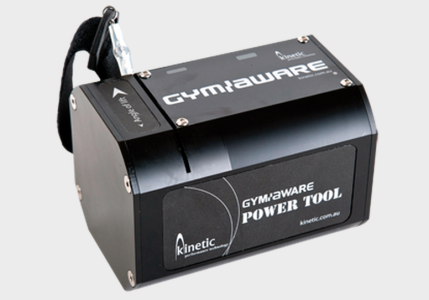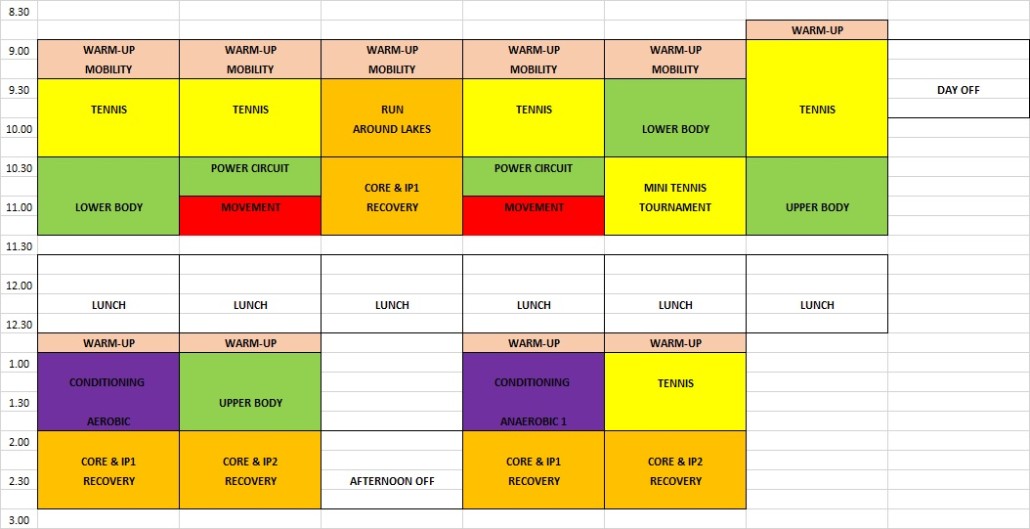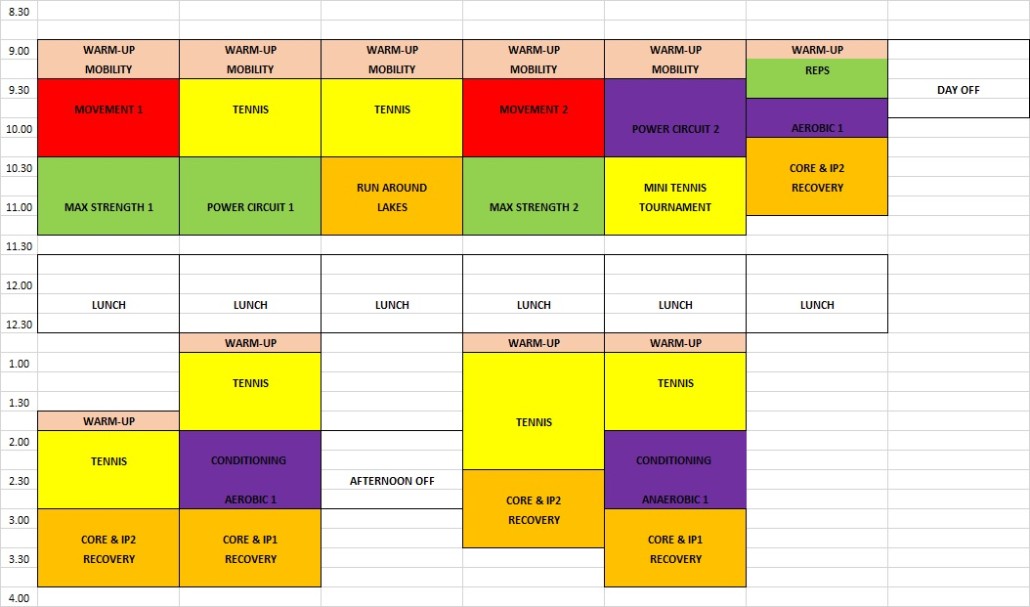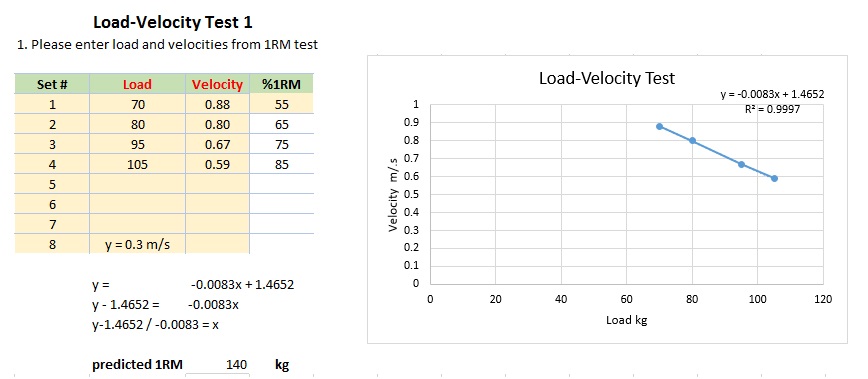What we learnt from the pre-season in 2015
Hi All,
firstly a very belated Happy New Year! I have had a week to readjust to the normal S&C schedule back at Gosling Tennis Academy where APA do most of their magic so thought I would give some feedback on the recent Professional Players Pre-season
Pre-season: 7th December 2015- 3rd January 2016.
In case you didn’t see the previous blog we ran a couple of different schedules.
Schedule 1:
Emphasis on Strength
Weekly schedule– an almost daily dose of strength training with a couple of conditioning sessions with half day rest on Wednesday and full day rest on Sunday.
Monday Lower body strength day is focused on knee dominant quadricep exercises. Tuesday is a power circuit which includes lower body strength exercises focused on hip dominant exercises which are paired with jumps and throws. Conditioning is on Monday and Thursday.
Schedule 2:
Emphasis on conditioning.
Weekly schedule– this plan was used with more senior professionals who were already achieving or expected to achieve high levels of strength (>1.5 x BM for a 1 Repetition Maximum on the Back squat). They were more focused on movement and conditioning.
Attendance:
There were 4 weeks of training available. We had nine regulars although 18 people were tested in total.
There were up to 14 sessions of S&C available each week although the most we saw players attending at base was 10. Some players did sessions at home. Some players were coming back later from tournaments and some players were leaving earlier to go to a tournament! This is the performance landscape of Tennis!!
The highest number of attended sessions over the four weeks was 25 in total. This represents about 45% supervised attendance. I would guess that would equate to about a 60% completion rate accounting for sessions done at home. So attendance was not as high as I would have liked.
Fitness testing procedure:
Strength testing:
We tested the players on the first day of week 1. I decided not to do a 1-Repetition Maximum (RM) test with the players on day 1 as they had variable amounts of recent strength training experience. I instead opted to use the Linear position transducer (GymAware) to determine bar speed using a submaximal protocol and estimate 1-RM.

Mladen Jovanovic has previously recommended a protocol using a submaximal range of 50-80% 1RM performing 3 squats with a 1-second pause at the bottom of each squat. See the full blog HERE
1-RM Squat Prediction
Long story short, one needs to know each lifter’s MVT (or minimal velocity threshold, a fancier term than velocity at 1RM) for every lift (or use generalized velocities—they can be pretty stable across different lifting abilities). Bench press tends to be 0.15 m/s (mean velocity) and squat around 0.3 m/s (mean velocity). One can then proceed by performing at least 3 warm-up sets with increasing weights (hopefully covering a range of at least 0.5 m/s) performed with maximal effort. Using simple linear regression, one can estimate weight at MVT. This can be 40%, 60% and 80% or 1RM. This can give one a quick estimation of 1RM (i.e. daily 1RM) that could be tracked over the duration of the training block and used to make adjustments if needed, or to basically see how the athlete is reacting to the training (if the goal is to increase 1RM).
Gymaware- what I learned.
Week 1:
I was too cautious and used a range of loads that were too narrow to cover the range of 0.5m/s. I deliberately underestimated their 1-RM by about 10-15% just to make sure I didn’t hit them too hard in day one with the > 80% 1RM loads. So for the athlete below I based the percentages off a 1-RM prediction of 125kg even though I knew he was probably capable of 140kg (10% higher).
The example above was actually the best of the linear regressions but even though the R2 value was almost perfect (indicating a strong relationship between changes in bar speed and load) the range of bar speed was only 0.88 to 0.59 m/s – much less than the recommended range of 0.5 m/s.
So the lesson learned is if you’re going to test their 1-RM then do it with some loads that will cause a bit of a drop off in bar speed closer to the 0.3 m/s speed we know 1-RM to occur at.
1-Repetition maximum scores :
When I retested in week 3 I used slightly higher loads to predict the 1-RM using the same protocol as above. In the final week more athletes were tested for their actual 1-RM. Other than athlete SP the linear regression was pretty accurate in predicting what the athlete would get in week 4.
Fitness test results:
For those of you not familiar with the protocols we use at APA to measure speed, power and stamina with the tennis players I will write about this in more detail in another blog and show some videos.
As already indicated, one of the challenges is that players are dropping in and out of sessions and have variable attendance. Of the 18 athletes who were tested either at the beginning or end of the training block, six athletes were able to complete both the test and re-test four weeks later.
For information, 9 of the athletes were Professional players and 9 were 18-and-under players. The average scores above were for the 9 professional players.
What was the biggest challenge?
The biggest challenge was that we had 4 weeks to train. I didn’t want to taper the third week so we could test without fatigue in week 4. That would only give us 2 weeks of full training. So all the tests in week 4 were conducted without a taper and as part of a training session. So if it was a power session we tested jumps, stamina was tested in the conditioning session and so on. So there was still fatigue in the athlete’s body.
Note: One athlete took part in the test-retest but did not take part in the pre-season so his data was omitted from the comparison below.
Those that took part in the test-retest trial improved in 25 out of 51 parameters, or 49%.
While the numbers are important to reflect on, perhaps some of the things that we really got out of the training block was a sense of camaraderie that is difficult to create in Tennis when often players are in and out of the Academy at different times because of their varying competition calendars.
Everyone was encouraged to send in videos and photos of their workouts they did away from the Academy and post on a group we were managing on whatsapp.
Here are some highlights:
Conditioning: Christmas day power circuit:
Overall it was a really good laugh, lots of players working hard and plenty of money in the bank for 2016!!!











